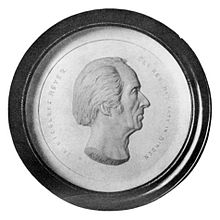Nikolaus Meyer (writer)

Nikolaus Meyer (also Nicolaus Meyer and Nicolaus Meier; born December 29, 1775 in Bremen , † February 24, 1855 in Minden ) was a German doctor and writer.
Life
Nikolaus Meyer was born as the sixth child of the Bremen councilor and law professor at the grammar school illustrious Heinrich Hermann Meyer and his wife Sophia Catharina Mindemann in Bremen. His grandfather was the mayor of Bremen, Volkhard Mindemann . From 1772 the family lived on Gut Wolfskuhle in Kattenturm . After taking private lessons with Friedrich Adolf Krummacher , Nikolaus Meyer first attended the grammar school in Bremen and later the pedagogy in Halle .
In 1793 he started in Halle a medical school , which he later in Kiel and Jena continued where he in 1800 with the signature Prodromus anatomiae Murium to Dr. med. received his doctorate. In Weimar he made the acquaintance of Johann Wolfgang von Goethe and lived temporarily in his house in 1799/1800. This led to a friendship with the Goethe family and, as a result, an extensive correspondence with Goethe himself, Christiane Vulpius and their son August .
Between 1801 and 1802 Meyer settled as a doctor and obstetrician in Bremen and opened a practice in his mother's house in the street “Vor dem Ansgaritor”. In 1803 he also became a spa doctor in Lilienthal near Bremen. In 1806 he married Sophia Doris Elisabeth Meyer. The family had eight children, five of whom died during Nicolaus Meyer's lifetime.
In 1809 he initially planned to move to Weimar - where he was appointed court counselor by the Grand Duke - but then moved (for unknown reasons) to Minden, where in 1816 he became "city and state physician" and in 1817 publisher of the Minden Sunday paper , which he up to 1853 directed. Together with Leopold von Hohenhausen he founded the “Westphälische Gesellschaft für die Cultur und das Wohl des Vaterlandes” (later “Westphälische Gesellschaft zur Fördervaterländischer Kultur”), which published the “Westphalian Provincial Papers”. Under his leadership, an important collection of works of art and historical objects, a natural history cabinet and a library were built for this society. He also translated medical texts from French and published medical articles in various journals.
In 1854 Meyer retired with the title of a secret government and medical councilor . He died on February 24, 1855 in Minden and was buried in Hausberge .
Works (selection)
- Tiefurth. A fantasy . Jena 1801.
- Kalloterpe. A polemical drama . Bremen 1804 (with illustrations by Ludwig Rullmann ).
- Flowers. 2. Parts in 2 volumes. 1st part: moments. Letters from Viktor's papers. 2nd part: poems . Heyse, Bremen 1804.
- Schiller's death celebration. At the theater in Bremen . Bremen 1806.
- The latest tales and tales from N. Langbein. Published by a bookseller . Bremen 1810/1822.
- Hennink der Hahn, freely translated from the old German original , Bremen 1814 by Johann Georg Heyse.
- Poems , Bremen 1814.
Honors
- Nikolaus Meyer became an honorary citizen of the city of Minden .
literature
- Ulrich Bornemann: New enthusiasm for antiquities. Nikolaus Meyer and the beginnings of excavations on the Lower Rhine. In: Calendar for the Klever Land for 2017. Mercator, Duisburg 2016, pp. 35–40.
- Hans Kasten: Goethe's Bremen friend Nicolaus Meyer: Correspondence with Goethe and the Weimar Circle. Bremen 1926, new edition by Severus: Hamburg 2014, ISBN 978-3863477905 .
- Hans Nordsiek: Nicolaus Meyer (1775–1855) and cultural life in Minden. In the S. (Ed.): Between cathedral and town hall - contributions to the art and cultural history of the city of Minden. City of Minden, Minden 1977, pp. 249-268.
- Heinrich Wilhelm Rotermund : Meier (Nicolaus). In: ders .: Lexicon of all scholars who have lived in Bremen since the Reformation. Schünemann, Bremen 1818, p. 35 f.
Web links
Individual evidence
- ^ Reference to the date of death according to the parish archives, see Nordsiek 1977, p. 268, note 108.
| personal data | |
|---|---|
| SURNAME | Meyer, Nikolaus |
| ALTERNATIVE NAMES | Meyer, Nicolaus; Meier, Nicolaus; Corti (pseudonym); N. Langbein (pseudonym); Philharmonic (pseudonym); Viktor (pseudonym); Victoro (pseudonym) |
| BRIEF DESCRIPTION | German doctor and writer |
| DATE OF BIRTH | December 29, 1775 |
| PLACE OF BIRTH | Bremen |
| DATE OF DEATH | February 24, 1855 |
| Place of death | Minden |
